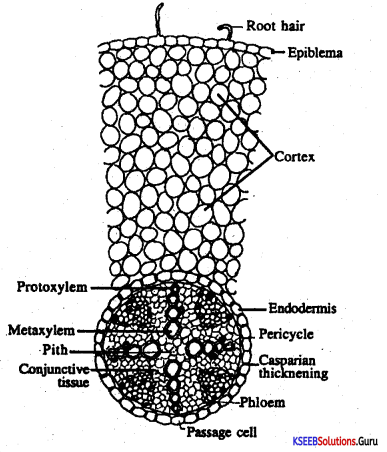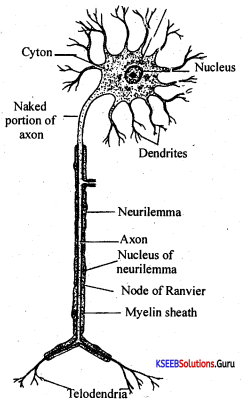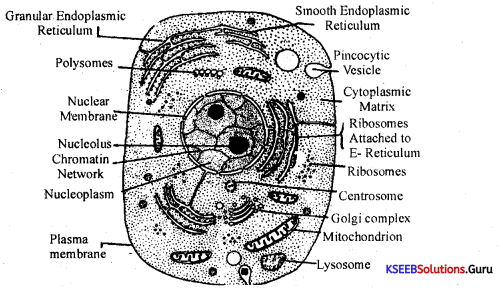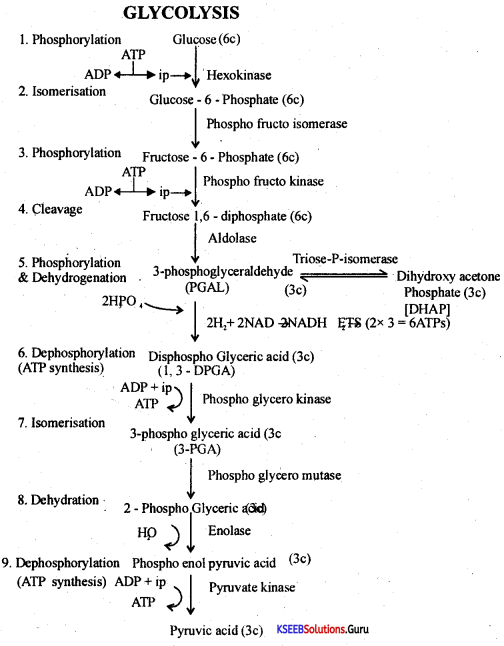Students can Download 1st PUC Biology Previous Year Question Paper March 2020 (South), Karnataka 1st PUC Biology Model Question Papers with Answers helps you to revise the complete Karnataka State Board Syllabus and score more marks in your examinations.
Karnataka 1st PUC Biology Previous Year Question Paper March 2020 (South)
Time: 3.15 Hours
Max Marks: 70
General Instructions:
- The question paper consists of four parts A, B, C, and D.
- All the parts are compulsory.
- Draw diagrams wherever necessary. Unlabelled diagrams or illustrations do not attract any marks.
Part – A
Answer the following questions in one word / one sentence each: ( 10 × 1 = 10 )
Question 1.
Define metabolism.
Answer:
It is the sum total of all molecular interactions that occur inside living organisms.
Question 2.
Which cell can fix atmospheric nitrogen in some of the cyanobacteria?
Answer:
Heterocyst.
Question 3.
What is venation?
Answer:
Arrangement of veins and veinlets on the lamina of a leaf.
Question 4.
Mitochondria are called Tower houses* of the cell. Why?
Answer:
They produce ATP.
Question 5.
Name the phase of the cell cycle which involves DNA replication.
Answer:
S-phase of interphase.
![]()
Question 6.
What is guttation?
Answer:
The loss of water ¡n liquid form through specialized structures called water stomata or hydathodes is called guttation.
Question 7.
Mention the technique of growing plants in a nutrient solution.
Answer:
Hydroponics.
Question 8.
Name the antibacterial agent present in saliva.
Answer:
Lysozyme.
Question 9.
What is tetany?
Answer:
It refers to the continued state of contraction or wild contractions of muscles due to low Ca in body fluids.
Question 10.
Define hormones.
Answer:
Hormone: Hormones are biochemical messengers secreted in minute quantities at a place and are transported to a target cell to induce a specific change in the target cell. Hormones have many functions.
PART-B
Answer any FIVE of the following questions in 3-5 sentences each, wherever applicable. (5 × 2 = 10)
Question 11.
List any two differences between chordates and non-chordates.
Answer:
| Chordata | Non-Chordata |
| (a) Presence of a solid notochord or a vertebral column. | (a) Absence of chordadorsalis. |
| (b) Presence of a dorsal and tubules nerve chord. | (b) Presence of ventral and solid nervechord. |
| (c) Presence of pharyngeal gillsilts. | (c) Absesnce of gilislits. |
| (d) Presence of ventral heart. | (d) Presence of dorsal heart. |
Question 12.
What are tendons and ligaments?
Answer:
Tendons: They are exclusively composed of white collagenous fibres arranged in regular bundles. In between these fibres, a few fibroblasts may occur. Usually, they connect muscle to bone.
Ligaments: They may contain both white and yellow fibres and these fibres are arranged in less orderly patterns. Usually, they connect bone to bone.
![]()
Question 13.
Why the Golgi apparatus remains in close association with the endoplasmic reticulum?
Answer:
- At end of the prophase of mitosis in animal cells, centriole duplicate and new daughter centrioles are formed.
- Give rise to basal bodies from which cilia and flagella arise.
- Distal centriole of sperm gives rise to axonemes or axial filament of the sperm tail.
Question 14.
Differentiate hypotonic and hypertonic solutions.
Answer:
(a) Hypotonic solution: It is a solution whose solute concentration is less than the solute concentration of the cell sap.
(b) Hypertonic solution: It is a solution whose solute conceñtration is more than the solute concentration of the cell sap.
Question 15.
Abscisic acid (ABA) is called the ‘Stress hormone’. Justify.
Answer:
It helps to overcome adverse conditions.
Question 16.
Mention two types of circulatory systems.
Answer:
Pulmonary circulation:
It includes the collection of deoxygenated blood into the right chambers of the heart and then pumping the same to the lungs for oxygenation, and bringing back the oxygenated blood from the lungs into the left atrium.
The superior vena cava and inferior vena cava collect the deoxygenated blood into the right atrium from anterior and posterior regions of the body respectively. Then it is pumped into the right ventricle. This, in turn, pumps it to the lungs, through the pulmonary artery for purification.
The oxygenated blood leaves the lungs through pulmonary veins which open into the left atrium.
Systemic circulation:
It includes the collection of oxygenated blood into the left chambers of the heart, and the distribution of the same to various tissues through the aorta, and its branches.
A set of four pulmonary veins bring the oxygenated blood from the lungs into the left atrium. The left atrium pumps the oxygenated blood into the left ventricle which shows powerful contractions. So the blood is pumped into the aorta under definite pressure.
Aorta gives off various branches in different directions for distribution. The blood exchanges oxygen, and carbon dioxide in the tissues of the body. Thus the blood is again deoxygenated. This deoxygenated blood is collected by superior and inferior vena cava and sent into the right atrium.
![]()
Question 17.
Write antigens on RBC’s and antibodies in the plasma of the universal donor blood group and universal recipient blood group.
Answer:

Question 18.
Bile juice contains no digestive enzymes. Then how does it helps for digestion?
Answer:
Bile juice is secreted by the hepatic cells of the liver and stored in the gall bladder. It is released into the duodenum through the bile duct. Bile juice doesn’t contain any digestive enzymes. But it contains the digestive components ¡n the form of bile salts Sodium Glycocholate, and Sodium taurocholate, Bile salts emulsify the fats by lowering their surface tension and convert them into numerous tiny droplets. Bile is rich ¡n sodium bicarbonate; hence it neutralizes the acidic chyme. It also helps in the absorption of fat-soluble vitamin K.
![]()
PART-C
Answer any FIVE of the following questions in 40-80 words each, wherever applicable: (5 × 3 = 15)
Question 19.
What is Binomial nomenclature? Write any two universal rules of nomenclature.
Answer:
Binomial Nomenclature:
This method was introduced by Carolus Linnaeus.
In this method, every organism is given a scientific name, which has two parts, the first is the name of the genus (generic name) and the second is the name of the species (specific epithet).
e.g. Mangifera indica for mangoes and Homo sapiens for human beings. In the above,
Man gera and Homo are generic names, while India and sapiens are the names of the species belonging to Man gilera and Homo respectively.
The classification consists of a hierarchy of steps where each step represents a range or category. The various ranges or categories used in classification are called Taxonomic categories.
Guidelines/Principles for nomenclature:
- Scientific names are, generally, written in Latin or derived from Latin, irrespective of their origin.
- The scientific names are written in italics or underlined. The first word denotes the name of the genus, and the second woixi denotes the species.
- The generic name starts with a capital letter, while the specific name starts with a small letter.
- The name of the author is written in an abbreviated form after the specific name e.g. Mangifera indica Linn.-indicates that this species was first described by Linnaeus.
- The name should be short, precise and easy to pronounce.
Question 20.
‘Flower is modified shoot’. Substantiate your answer.
Answer:
The flower is a modified shoot: When the stem takes on the role of general reproduction it is modified into a flower. That is why flower ¡s often called a modified shoot.
Question 21.
Write about the significances of meiosis.
Answer:
Significance of Meiosis:
- Meiosis brings genetic crossing over and random distribution of paternal and maternal chromosomes to daughter cells.
- Recombination produces variations and variations are the sources of organic evolution.
Question 22.
How is mycorrhizal association helpful in the absorption of water and minerals in plants?
Answer:
The hyphae have a large surface area from an Ammonotebic large volume of soil.
![]()
Question 23.
List any three physiological roles of cytokinins.
Answer:
- Discovered by Skoog and Miller
- Chemically these are 6-fur furyl amino purlins.
- Synthesised in young fruits, leaves, buds, root tips and translocated through the xylem.
- Cytokinins stimulate cell division.
- Cytokinins prevent early ageing or senescence by stabilizing proteins and chlorophyll. This phenomenon is called Richmond – Lang effect.
- Cytokinins break seed dormancy and induce germination.
Question 24.
Briefly explain disorders of the Respiratory system.
Answer:
- It is the inflammation of bronchi, leading to breathlessness, chest tightness, light sneezing, and cough with the expulsion of yellow or green sputum.
- It is the parietal blocking of bronchi and bronchioles, resulting in breathlessness, chest tightness, wheezing and dry cough.
- Emphysema is the condition, where the walls of the alveoli lose their elasticity and remain rigid due to a permanent air-filled condition.
Question 25.
Mention three types of body movements.
Answer:
- Amoeboid Movement: Macrophages and Neutrophils.
- Ciliary Movement: Epithelium of nasal tract, urinary tubule and fallopian tube.
Question 26.
Classify the animals based on nitrogenous wastes excreted by them.
Answer:
Ureotetic (Urecotelic).
Part-D (Section -I)
I. Answer any FOUR of the following questions in 200-250 words each. (4 × 5 = 20)
Question 27.
Write five salient features of Bryophytes.
Answer:
(1) They are non-vascular plants, exhibiting amphibious habitats.
(2) Gametophytic phase of the life cycle is represented by a multicellular, haploid thallus, which is called gametophyte.
(3) Gametophytic plant body bearing male and female sex organs, represents the dominant phase of life cycle unlike in higher plants.
(4) Gametophyte is autotrophic and independent in nature.
(5) The gametophyte produces sex organs, the antheridia and the archegonia which are multicellular Antheridia may be embedded within the thallus or may be specifically located at the tips of the gametophyte. It produces biciliate curved antherozoids.
Archegonia is a flask like structure. It bears a basal bulbous vendor and a narrow, hallow structure at it is summit called the neck. Within the venter, the female gamete or egg ¡s situated along with a venter canal cell. The neck shows neck cells, neck canal cells and cover cells.
(6) Fertilisation takes place in the presence of water, leading to the formation of a zygote which later develops into a multicellular embryo. Hence, the group is treated under embryophytes.
(7) Sexual reproduction is always of the Ougamous type.
(8) Embryo develops into a diploid sporophyte consisting of the foot, seta and capsule, which is dependent on the gametophyte.
(9) Diploid sporophyte reproduced by the formation of haploid spores (meiosis occur during spore formation). The spore germinates and produces gametophytes.
(10) In their life cycle, such distinct heteromorphic alternation of generations is shown by the members.
Question 28.
(a) Describe three types of simple epithelial tissues based on structural modification of the cells.
Answer:
Epithelial tissue ¡s a tissue, which lies on the upper and outer layer covering the surface of the organ or lining the cavity.
Squamous epithelium:
a. It occurs in the skin of vertebrates. Alveoli of lungs, the mouth cavity, etc.
b. The cells are nearly hexagonal flat and plate-like.
c. A spherical or oval nucleus is found to be present at the cell centre.
d. The cells are closely fitted with minimum intercellular space. Hence they look like mosaic pavement. Because of this, the squamous epithelium is also called pavement epithelium.
e. It forms a continuous cover and protects the inner tissues.
Columnar epithelium:
a. it occurs in the mucosa membrane of the stomach and the intestine.
b. The cells are elongated and pillar-like. The lower ends are narrow and the upper ends are broad.
c. The nucleus is oval and the basal cytoplasm is granular.
d. Cells are lodged over a basement membrane. Intercellular spaces are present at the basal region of the cells.
e. The columnar cells are absorptive and protective in function.
(b) Write any two functions of bones.
Answer:
Structure support.
Question 29.
Draw a neat labelled diagram of T.S. of Dicot Root.
Answer:

![]()
Question 30.
Explain any five classes of enzymes based on the type of reactions they catalyse.
Answer:
- Oxidoreductases: Act on many chemical groupings to add or remove hydrogen atoms.
- Transferases: Transfer functional groups between donor and acceptor molecules. Kinases are specialised transferases that regulate metabolism by transferring phosphate from ATP to other molecules.
- Hydrolases: Add water across a bond, hydrolyzing it.
- Lyases: Add water, ammonia or carbon dioxide across double bonds, or remove these elements to produce double bonds.
- Isorne rases: Carry out many kinds of isomerization: L to D isomerizations. Mutase reactions (shifts of chemical groups) and others.
- Ligases: Catalyze reactions in which two chemical groups are joined (or ligated) with the use of energy from ATP.
Question 31.
Mention any one importance of the following macronutrients.
(a) Nitrogen (b) Phosphorus (c) Potassium
Answer:
Macronutrients: They are essential elements that occur in a concentration of 1-10 mg/g of dry matter, e.g., C, H, O, N, P, K.
Micronutrients: They are essential elements that occur in plants in a concentration of 0.1 mg or below per gin of dry matter, e,g,, Mn, Zn, Cu, Mo, Bo.
Beneficial Nutrients: They are non-essential elements that have some specific role in some plants, e.g., Na4 in Ç pLants, Si in grasses.
Toxic Elements: They are non-essential elements which if absorbed reduce plant growth, and yield. Many elements become toxic only after their concentration reaches a particular level, e.g., Lead, Aluminium, Mn.
Essential Elements: They are those elements that are involved in some vital structural, and functional role in plants so that their deficiency will cause disorders while their absence results in non-completion of the life cycle, e.g., C, l-I, O, N, P, K Ca, Mg, S, etc.
Question 32.
Draw a neat labelled diagram of multipolar Neuron.
Answer:

Section-II
II. Answer any THREE of the following questions in 200-250 words each, wherever applicable. (5 × 3 = 15)
Question 33.
List any five characters of class Aves.
Answer:
- Birds are homeothermic (warm-blooded) animals.
- The body is boat-shaped and is adapted in such a way as to offer the least resistance while flying
- The body is differeñtiated into ahead, long neck, a trunk and a short tail.
- The body is covered by feathers, which provide insulation.
- Forelimbs are modified into wings for flight. Wings are provided with feathers, which are bad conductors of heat.
Question 34.
Draw a neat labelled diagram of the Animal cells.
Answer:

Animal Cell – Ultrastructure
![]()
Question 35.
(a) State Blackmail’s law of limiting factors.
Answer:
The law of limiting factor states that “when a process is governed by a number of separate factors, the rate of the process is limited by the pace of the slowest factor”. Photosynthesis is influenced by several factors such as CO2 concentration, availability of water, sunlight etc. Any of these factors may become a limiting factor at any one moment and may limit the rate of photosynthesis.
(b) Mention external factors affecting photosynthesis.
Answer:
Light, temp H2O, CO2
Question 36.
Give the schematic representation of Glycolysis.
Answer:
- It occurs in the cýtoplasm of the cell.
- It is an enzymatic reaction, thus temperature sensitive.
- It is a common reaction for both aerobic and anaerobic respiration.

Question 37.
Name any five hormones secreted by the pituitary gland and mention anyone function of each.
Answer:
1. The pituitary gland weighs about 0.5 gm and is a pea-sized endocrine gland that lies on the ventral surface of the brain attached to the hypothalamus by a nervous stalk called the infundibulum.
2. It is called the master gland or conductor of the endocrine orchestra as several of its hormones control other endocrine glands directly. The hormones of the pituitary that influence other endocrine glands are called tropins or trophic hormones. However, the pituitary gland itself works under the influence of the hypothalamus through releasing factors. The pituitary gland is called the master gland because it controls the functions of other endocrine glands by secreting hormones.
3. Based on origin, it is divided into two parts namely Adenohypophysis and Neurohypophysis.